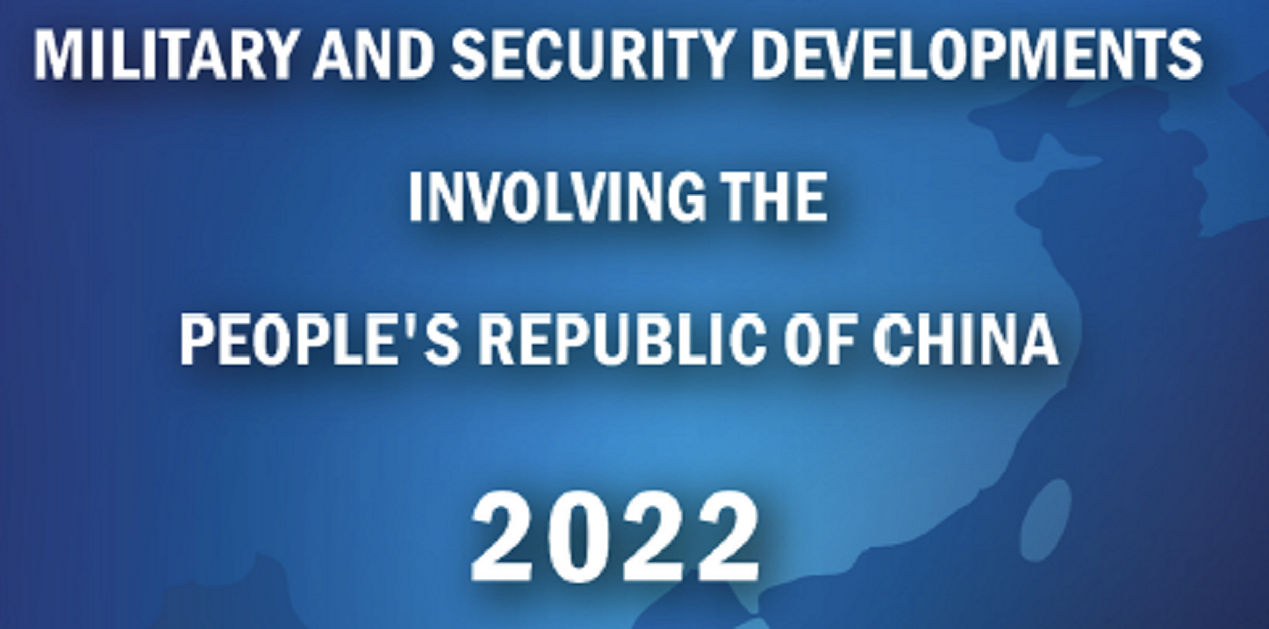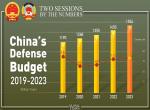On 29 November 2022, the US Department of Defence released the 2022 annual report on “Military and Security Developments Involving the People’s Republic of China” in which “China’s drive to dominate emerging technologies” figure prominently. Though previous Pentagon reports mentioned about the growing challenge posed by China and Beijing’s race to develop cutting-edge technologies. The 2022 report underscores China’s determined pursuit of ‘superiority’ and ‘drive to dominate’ in the emerging technologies. The 196-page US Congressionally mandated report also dives into China’s defence capabilities and foreign policy strategy, which the Pentagon sees as “the most consequential and systemic challenge to US national security and the free and open international system.”[1]
While China’s growing nuclear capability and its plan to increase from current level of 400 nuclear warheads to 1,500 nuclear warheads by 2035 has attracted much of the media attention. Much attention has not been paid to China’s race to acquire emerging technologies such as artificial intelligence (AI), autonomous systems, semiconductors, quantum technologies, advanced materials and its intent to use these technologies to further enhance its military capabilities. A closer analysis of this aspect reflects that the People’s Liberation Army (PLA)’s growing advanced military capabilities and Beijing’s plan to use these newly acquired capabilities to expand its presence deeper into the Indo-Pacific region and beyond creates serious security and strategic challenges for the US and also regional countries, including India. In this regard, the Pentagon report rightly points out that the PLA is “developing the capabilities to conduct military operations deeper into the Indo-Pacific region, and in some cases globally.”[2]
China’s Emerging Technology Strategy
On China’s emerging technology strategy, the Pentagon report states that “China seeks to be an innovation superpower that is largely non-reliant on foreign technology and that serves as a global centre for high-tech industries.”[3] It is in fact well on its way to becoming a superpower in important areas of innovation and emerging technologies. The Belfer Center for Science and International Affairs in its December 2021 report emphasised that China has “displaced the US as the world’s top high-tech manufacturer” and “become a serious competitor in the foundational technologies” such as AI, 5G, semiconductors, quantum technology, biotechnology and green energy.[4] It stressed that China has already become number one in some areas and will overtake the US in others within the next decade.
China has adopted a “whole-of-society approach” to develop emerging technologies and become “non-reliant on foreign technology”. The ‘Made in China 2025’, a strategic and industrial policy first announced in May 2015, aims to increase the domestic content of core materials to 40 percent by 2020 and 70 percent by 2025.[5] The policy promotes domestic innovation by setting higher targets for domestic production of emerging technologies and services. This policy strengthens China’s domestic industries by providing financial and other incentives, “while increasing pressure on foreign firms to transfer technology to have market access in China.”[6] Though China has begun to avoid reference to ‘Made in China 2025’ after the plan came under criticism from the advanced industrialised countries for unfairly favouring China’s domestic industries at the cost of foreign participants in its market. It continues to promote domestic innovation and manufacturing through its ‘economic policies’ by favouring domestic industries, “while placing additional restrictions on foreign firms.” In its 14th Five-Year Plan, which was drafted in the backdrop of deteriorating US-China relationship and embedded tech war, China reemphasized its goal of achieving self-sufficiency in the science & technology (S&T) sectors.[7] In this regard, it has mobilized its bureaucracies to rapidly develop the country’s capacity for domestic innovation and manufacturing of ‘core technologies’.
The report points out that “China is particularly focussed on dominating a range of emerging” technologies which could potentially become “both disruptive and foundational for future economies”. These technologies include AI, autonomous systems, quantum technologies, smart city platforms, biotechnology, advanced materials and manufacturing.[8] This will pose significant defence and strategic challenges for the US and other Indo-Pacific countries, given their military applications. At the same time, China has a clear understanding of its current S&T deficiencies, particularly its vulnerability and reliance on western companies for enabling technologies such as semiconductors, new materials and S&T talent pool. As a result of these vulnerabilities, China has focussed on its industrial policies and massive technology transfer apparatus in an effort to reduce these dependencies, ensure their resilience, and to become a market leader in emerging technologies. It also sustains high levels of research & development (R&D) funding and offers significant subsidies to domestic industries working on these emerging technologies, and has developed a focussed effort to improve domestic education, attract overseas Chinese as well as foreign tech talents.
China’s Military Application of Emerging Technologies
So far as the use of emerging technologies to further enhance its defence capabilities is concerned, “China designates AI as one of its priority S&T development areas and assesses that advances in AI and autonomy are central to intelligentized warfare”. [9] China’s concept of ‘informatised warfare’ began after it drew lessons from the Operation Desert Storm of 1991 where the American forces used integrated information networks and Precision Guided Missiles (PGM) to quickly defeat Iraq’s strong conventional forces. Following which PLA gave priority for gaining mastery over this warfare. As the PLA continues to sharpen its “focus on improving its ability to fight and win informatized wars”, the report states that it will further use emerging technologies such as AI, automation, big data, the internet of things (IoT) and cloud computing to improve process efficiencies. In fact, the PLA has already begun implementing big data analytics “to improve automation and to create a comprehensive, real-time picture for warfighters”.[10] Importantly, China views the integration of civil and military institutions “as central for developing AI-enabled military capabilities”. In this regard, it has established civil-military “R&D centers and procured commercially-developed AI and robotic technologies to ensure PLA access to cutting-edge AI technologies.”[11]
The report recognizes that the Chinese “researchers are world leaders in certain AI applications, such as facial recognition and natural language processing” and Chinese tech industries are prioritizing on domestic design, development, production, and marketing AI chips. Although it currently depends on certain foreign technologies and materials “to produce AI hardware, such as advanced semiconductor fabrication factories and electronic design automation software”, Chinese “researchers are exploring new materials and design concepts for next-generation semiconductors” which will further advance indigenous development of emerging technologies and military capabilities. China “has also designed and fabricated a quantum computer capable of outperforming a classical high-performance computer for a specific problem”.[12] China’s growing military assertiveness in the Indo-Pacific region is clearly related to these newly acquired technological and military capabilities. As its war-fighting capabilities grow, China will clearly pursue its strategic interests in the region by expanding PLA’s presence. This whole-of-society approach is challenging America’s primacy in the region and also its “traditional advantages in the macro-drivers of the technological competition”, including national policies, R&D ecosystem and technology talent.[13]
US Strategy to Counter China’s Tech Dominance
The Biden administration has broadly adopted three pronged strategies to counter China’s drive to dominate emerging technologies: i) Building a strong domestic technology industrial-base by making huge investment in high-tech sector; ii) Brought a range of legislative measures to control export of advanced technologies and materials to China; and, iii) Mobilising its key allies and partners to join in its export control efforts to restrict Chinese access to advanced technologies, materials and services. This clearly reflects in the administration’s Indo-Pacific strategy, National Security Strategy (NSS) and National Defence Strategy (NDS) which view China as a ‘pacing challenge’ to America’s primacy and national interest. Pentagon’s 2022 report is in consistent with the administration’s ongoing efforts to counter China’s growing technological and military capabilities. Moreover, with the steady decline of US-China relationship, Beijing’s stance towards Russia and its aggressive policy towards Taiwan, especially since US House Speaker Nancy Pelosi’s two-day visit to Taiwan in August 2022, have further accelerated the technology and economic decoupling.
Nevertheless, a major concern for Washington as well as regional countries is how quickly China is moving ahead in developing these cutting-edge technologies and also its ability to acquire foreign technologies, materials and S&T talent pool, despite America’s best efforts to restrict Chinese access to these. The US is particularly concerned about China’s leveraging of emerging technologies such as AI, autonomous systems, cyber, quantum, among other advanced military technologies to challenge America’s primacy and interests in the Indo-Pacific region. China also continuously targets the US as a major threat to its security and national interests which enables it to amplify its great power narrative and shape the region to its advantage.[14] This ‘stiff competition’ for technology dominance between the US and China will have spillover effects in the Indo-Pacific region and beyond.
Implications
While China’s strategy to develop and dominate in the areas of emerging technologies, military application of these technologies, PLA’s expanding presence in the Indo-Pacific region and the continuous worsening of India’s relationship with China have created multiple security and strategic challenges for India. This has brought India and the US further closer and their relationship has transformed into a ‘Comprehensive Global Strategic Partnership’ based on their shared values and interests on a wide range of areas, including defence, technology, economic and people-to-people ties. The Pentagon report reveals that during the India-China border conflict along the Line of Actual Conflict (LAC) in June 2020, the Chinese “officials have warned US officials to not interfere with” its relationship with India and downplaying the severity of the conflict, Beijing had tried “to prevent border tensions from causing India to partner more closely with the United States.”[15] The India-China border conflict and China’s increasing assertive foreign policy in the Indo-Pacific region resulted in further strengthening of India-US defence cooperation. For instance, the US supplied two MQ-9B military drones to India for surveillance and strike missions,[16] earlier Washington was reluctant to provide military drones to India, and the two countries signed the Basic Exchange and Cooperation Agreement (BECA) for Geospatial Cooperation agreement which enables India to get real-time access to American geospatial intelligence.[17]
Amidst these growing concerns over China’s use of newly acquired technological and military power in support of its expansionist goal, India and the US have thus strengthened their cooperation in the field of defence and emerging technologies. In fact, the US wants to become India’s ‘partner of choice’ in defence and strategic technology sectors. It considers India as a ‘critical’ partner in its vision of a free, open, resilient and secure Indo-Pacific region. The Biden’s NSS also underlines India as a ‘Major Defence Partner’ and the NDS expresses American interest to strengthen India’s defence capability to counter Chinese ‘aggression’. It expects that India’s rise would help balance assertive China in the Indo-Pacific region and beyond. However, the unfolding US-China technology rivalry and ‘stiff competition’ between the two countries to develop and deploy emerging technologies to shift military and economic balance to their advantage will further shape the structure of international relations which will have serious regional and global ramifications in the years ahead.
Endnotes:
[1]Military and Security Developments Involving the People’s Republic of China 2022, Annual Report to the US Congress, US Department of Defence, Office of the Secretary of Defence, Washington DC, 2022, p. 1.
[2]Ibid. p. 80.
[3]Ibid. p. 151.
[4]Graham Allison, Kevin Klyman, Karina Barbesino and Hugo Yen, “The Great Tech Rivalry: China vs the US”, Harvard Kennedy School, Cambridge, Paper 7 December 2021, p. 2.
[5]Sara Hsu, “Foreign Firms Wary of ‘Made in China 2025,’ But It May Be China's Best Chance at Innovation”, 10 March 2017 at https://www.forbes.com/sites/sarahsu/2017/03/10/foreign-firms-wary-of-made-in-china-2025-but-it-may-be-chinas-best-chance-at-innovation/?sh=677489df24d2. Accessed on 11 December 2022
[6]Note 1, pp. 21-22.
[7]See China’s 14th Five-Year Plan, covering the years 2021-2025, as passed by the Chinese parliament, the National People’s Congress, on 13 March 2021 available at https://cset.georgetown.edu/publication/china-14th-five-year-plan/. Accessed on 11 December 2022.
[8]Note 1, p. 151.
[9] Ibid.
[10]Ibid. p. 85.
[11]Ibid. p. 151.
[12]Ibid. pp. 151-52.
[13] Note 4, p. 4.
[14] Note 1, p. 140.
[15] Ibid. p. 117.
[16] “India Leases Top-Notch US Drones for Surveillance amid Border Row with China”, The Times of India, 16 November 2020 available at https://timesofindia.indiatimes.com/india/india-leases-top-notch-us-drones-for-surveillance-amidst-border-row-with-china/articleshow/79413719.cms. Accessed on 12 December 2022
[17] “India, US Sign Landmark Defence Pact amid Border Standoff with China”, Business Today, 27 October 2020 available at https://www.businesstoday.in/latest/economy-politics/story/india-us-sign-landmark-defence-pact-amid-border-standoff-with-china-276825-2020-10-27. Accessed on 12 December 2022.
(The paper is the author’s individual scholastic articulation. The author certifies that the article/paper is original in content, unpublished and it has not been submitted for publication/web upload elsewhere, and that the facts and figures quoted are duly referenced, as needed, and are believed to be correct). (The paper does not necessarily represent the organisational stance... More >>
Image Source: https://news.usni.org/wp-content/uploads/2022/11/Screenshot-2022-11-29-at-12.27.56-PM.png










Post new comment